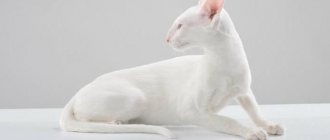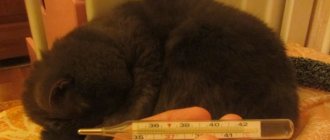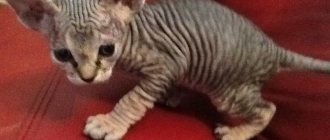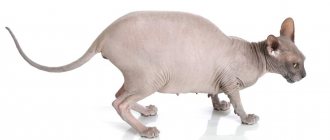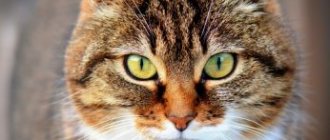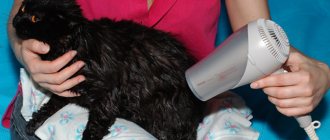Home Animals Cats
Title 1: How to properly wash a cat: how often, at what temperature and why 2 title: Washing a cat at home - choosing products, drawing up a plan, preparing the animal and contraindications. [[[How to properly wash a cat? Is this unpleasant procedure necessary or is it a tribute to fashion? It is necessary to wash, and correctly. You need special shampoos, a little patience and a good mood. There are cases when washing a cat is impossible or undesirable.]]]
It's rare that a cat has a love for water treatments. But nevertheless, pets are often exposed to this action. But bathing is a lot of stress for a cat, so it resists in every possible way. For an inexperienced owner, everything can end in serious scratches. True, cats accustomed to washing from childhood do not react so violently to bathing and are practically not afraid of water.
Cat owners often think about the advisability of water procedures and doubt how correctly they do it and with what frequency. This is a necessary procedure and it is dangerous to ignore it. At the same time, you need to bathe correctly and not when the owner wants. Washing too often can be harmful!
What cosmetics should you choose for your pet? Human gels, shampoos, foams and soaps are not suitable for animals. This is explained by the different acid-base balance of cats and humans. Therefore, you need a special zoo shampoo. By the way, there are products for so-called “dry cleaning”. Special sprays or dry shampoos perfectly clean the coat. However, the procedure should not be abused. Another way to put an animal in order when it is not possible to take a full bath is a “bath” made from bran. True, it is only suitable for short-haired cats; long-haired breeds are not recommended due to the formation of tangles.
Washing kittens deserves special attention. At what age should a baby be introduced to water? How can I help him overcome his natural fear? How much time should you devote to such procedures? There are many questions, but there are answers to them. And we will try to tell you in detail how to wash a kitten and an adult cat. A cat in the bath can behave differently, especially if its first acquaintance with water took place as an adult.
Why bathe a cat?
The cleanest animal on the planet is a cat, of course, provided that it is healthy. She takes care of her fur herself, licking it literally centimeter by centimeter, removing microparticles of dust. The more she travels through her territory, the more meticulously she licks her fur, licking away dirt and unpleasant odors. Seeing such neatness, it is difficult to understand why the animal needs to be washed. They cope well with this task on their own. The tailed princesses lived in villages for centuries, caught rats, and no one ever bathed them. Why did they start doing this now? Maybe this is nothing more than a tribute to fashion?
Let's go back 100 years to a small village. The rivers have clean water, lush greenery grows around, birds sing, there are no garbage dumps or landfills. Pure ecology and grace. What's outside the window today? Exhaust fumes, viruses and germs, dirty basements, acid rain. All this settles on the cat's fur. It is impossible to see the danger with the naked eye, but this does not mean that it does not exist. But the problem is much more serious than it seems, because all harmful substances enter the gastrointestinal tract, causing diseases. And washing a cat is much easier than treating it for diseases.
Frequent bathing can also be dangerous. You need to understand that the fur is covered with a protective lubricant, which is produced by the subcutaneous sebaceous glands. And frequent washing can deprive the cat of its natural protection. It is advisable to wash your cat 2-3 times a year, but this does not apply to washing dirty paws.
And if the animal does not leave the apartment, it means it does not collect dangerous microbes and substances from the street. Maybe you don't need to wash it? Experienced breeders say that there is a fair amount of dirt and danger within the apartment. And you shouldn’t give up water procedures, although they can’t be done that often.
There are direct indications for bathing representatives of the feline family:
- Heavily contaminated wool, regardless of the origin of the contamination - synthetic or natural.
- Presence of parasites.
- For preventive purposes.
There is one more point that you need to remember - this is molting. When a cat licks itself, hair gets into the stomach, and during the molting period its amount increases several times. It may be difficult for an animal to cope with its elimination naturally, which negatively affects the digestive system. To avoid troubles, the bathing schedule must be drawn up so that the procedure coincides with the molting period.
Contraindications for swimming:
- You should not bathe a sick animal.
- There should be at least 4 hours between bathing and eating. Under no circumstances should you send your cat to the bathroom on a full stomach.
- There is no need to create stressful situations (turn on the water loudly, rattle basins, etc.).
- Long-haired cats need to be brushed well before bathing.
- Frequent bathing can harm your pet.
Before considering the procedure itself, it is worth choosing the right shampoos for washing.
How to wash a cat?
Under no circumstances should you use regular soap or human shampoo. Today there are special zoo shampoos on sale, and they are:
- dry;
- in the form of a spray;
- liquid.
Dry shampoo is the best option as it is easy to apply to the coat. After a certain time, the powder is simply combed off, and all the dirt is removed along with it. In terms of effectiveness and safety, it is not inferior to conventional liquid shampoos, and also makes combing easier. It will be an excellent solution if the animal has a panic fear of water. Another advantage of using a dry product is that the wool will be dry and does not need to be dried. When dry washing, do not be afraid of water getting into your ears and eyes. Excellent for frequent washing, because they do not damage the fat layer and do not dry out the skin.
The principle of operation of a spray shampoo is the same as a dry product. Sprays are not very common, so purchasing them in a store is not so easy, even despite their ease of use. Unlike dry sprays, they can provide antistatic protection to wool. They make combing easier, which is important for animals with long hair. It should also be taken into account that the sprays have a fairly persistent and pronounced aroma.
Liquid products do an excellent job of removing different types of dirt and make the coat smooth and silky. There are specialized shampoos that help deal with ticks, fleas, etc. By the way, medicated shampoos can be used no more than 1-3 times a year, as they disrupt the functioning of the sebaceous glands. Liquid shampoos are considered the most popular and this is not in vain, because they can easily cope with tangles, severe dirt and small parasites.
What makes cats afraid of water?
Driven by curiosity, scientists have put forward several theories to explain the causes of irrational phobia in most members of the cat family. In the course of their research, they came to the conclusion that it is not fear that motivates cats to avoid contact with water, but the instinct of self-preservation.
Whiskered pets not only hunt well, but also swim well
Table 1. Main factors provoking fear of water procedures
| Cause | Explanation |
| Risk of hypothermia | There is an air cushion between the top layer of hair and the dermis. It absorbs heat emanating from the body and warms the pet. When wool gets wet, it loses its insulating properties. |
| Possibility of overheating | The air gap protects from overheating by preventing exposure to sunlight. For dogs, for example, to survive the heat, it is enough to breathe with their tongue hanging out. Cats that do not have this ability can only rely on a pillow. |
| Increased smell | When the fur gets wet, it gives off a strong odor and makes the animals vulnerable to large predators. In addition, such a clear cat scent complicates the hunt. The victim senses the approach of the enemy and manages to escape in a timely manner. |
| Growth of pathogenic bacteria | Wet hair absorbs more dust than dry hair. When washing, dirt enters the cat's stomach and provokes the proliferation of harmful microbes. |
Zoologists believe that cats are aware of the negative consequences of bathing and do not want to put themselves at risk. They remember at the genetic level that wet wool contributes to heat loss.
Unlike cats, dogs can shake off water.
While observing the behavior of cats and dogs, researchers made another interesting discovery. Representatives of canines are active hunters. In pursuit of prey, they cover long distances. If they need to dry off, they either shake off drops of water or get rid of moisture while jogging.
It is important that water does not get into your cat's ears while bathing.
It is advisable to bathe an adult cat that is afraid of water and struggles to get out of the bath together.
- Fill the bath with water at a level of 10-15 cm, depending on the size of the cat.
- The water is turned off.
- The animal is carefully lowered into the water, its fur is wetted with a sponge, very carefully. Never immerse a cat in water with its head.
- The shampoo is diluted with water according to the proportion indicated on the package. They lather the animal's fur with it.
- Remove the shampoo immediately or after some time, scraping off the foam with a brush, watering the animal from a ladle or shower under thin streams.
- Like a kitten, dry and warm the cat with a towel. Change it when it gets wet. It is advisable to dry an animal with long hair with a hairdryer with warm air.
- If after bathing the cat decides to retire and lick itself, there is no need to disturb it.
We invite you to read: White cat review of snow-colored breeds
After bathing, the cat needs to be warmed and dried.
Preparing to wash
It is best to wash your cat with dry shampoo on the bare floor. This will make it much easier to remove any remaining powder from the floor. When choosing sprays, you need to remember that the animal may be frightened by the sizzling sounds. If you notice fear, then the procedure should be stopped immediately and the pet should be calmed down. When choosing liquid shampoos, do not neglect careful preparation. The animal is not fed 3-4 hours before washing. Try not to rattle basins or water, because cats are very sensitive. Immediately before washing the cat, you can pick it up, stroke it, and calm it down.
Trim your nails in advance to protect yourself from scratches. A manicure should be done a few days before washing, so that the cat can calm down before the next traumatic procedure. Next comes combing, which pets don’t really like. It should be done at least a day before washing.
How to accustom a cat to water, because she is terribly afraid of it? This should be a calm, gradual acquaintance. Periodically, the animal is placed in an empty bath or basin, giving the opportunity to become familiar with the new space. Cats can play with the water droplets, which they really like. The next step in getting acquainted with water will be wiping the fur with a damp cloth. If this prompted the pet to wash itself, then this is a good sign - the cat feels it. The moment has come when she behaves calmly in the bathroom, which means it’s time to get acquainted with warm water. Kittens adapt more easily, and the procedure can become a favorite and enjoyable one for them. Adults are unlikely to feel calm and relaxed.
Before bathing, play with the animal to make sure it is calm and in a good mood. All necessary accessories must be prepared in advance in the bathroom. You should have pet shampoo, a soft towel, a comb, a brush, a plastic container or a hand shower head on hand. To protect your eyes, it is recommended to purchase a special ointment.
The bathing area can be a bathtub or sink. Be sure to place an anti-slip mat on the bottom and fill the container with warm water (be sure to check the water temperature!). It also wouldn’t hurt for the owner to prepare – wear clothes that will protect from sharp claws, water and foam.
It is best to bathe a cat together - one holds it and the other washes it. Don't let your guard down - the cat can break free and run away in the blink of an eye. To avoid trouble, keep the bathroom door closed.
How to properly wash cats?
Now comes the turn of practical actions, and it’s time to learn how to properly wash a cat. Even the best shampoo will be useless if you do the procedure incorrectly. To make it as pleasant (as possible) and effective, you need to adhere to the following plan:
- Remove any loose hair by combing and untangling tangles.
- Protect your ears with cotton swabs.
- If you bought concentrated shampoo, then it must be diluted in accordance with the instructions given.
- Remove away anything that your pet could accidentally snag, knock over, or damage.
- Fill the container with water; its level should reach the cat’s stomach.
- The optimal temperature is 37 degrees.
- A mat (or a folded towel) has already been laid at the bottom of the container, and now calmly, without nerves, without haste, put the cat in the bath.
- After placing the cat in the bath, begin to gradually water it from the shower or plastic container. There is no need to apply strong pressure. Try not to pour water on your head.
- After thoroughly wetting the coat, apply shampoo, gently rubbing it in. If possible, do not rinse the shampoo for a couple of minutes.
- Rinse off the shampoo thoroughly and apply conditioner if desired. And if the cat is very dirty or has problems with its fur, it is recommended to reapply shampoo.
- Shampoo and conditioner must be rinsed off completely, as any remaining product attracts dirt and dries out the coat.
- After the bathing procedure, wrap the cat in a soft towel, waiting until it absorbs moisture. Rubbing the body with a towel is strictly prohibited.
- If necessary, you can dry the fur coat with a hairdryer, but if the room is warm enough, then this is not necessary.
Proper washing of a cat means washing without violence. Show affection, use persuasion - the pet will adapt much faster. The psychology of animals is designed in such a way that with complete trust in the owner, they endure the most unpleasant manipulations much easier.
Drying wool correctly
The animal should not be cold after bathing, so it is wrapped in a towel that absorbs excess moisture.
Then the towel is replaced with a dry one and the pet is taken to the room. It is important to create a comfortable air temperature in the room (about 24⁰ C), and close the windows tightly. A cat can easily catch a cold from a draft. Persians, Scots, Siamese, sphinxes and rexes are especially sensitive to cold.
The hairless cat needs to be thoroughly dried, gently blotting the body, but without rubbing. And then wrap it in a dry, warm towel and hold it in your hands until it is completely dry and warm. Some breeders advise lubricating the skin with baby cream or natural oil (shea, olive, palm).
Do not bring the device closer to a distance of less than 30 cm from the cat. For drying, slow or medium speed and gentle mode are suitable. It’s great if you have a low-noise hairdryer in your home. First of all, the air stream is directed to the head, then the chest, front legs, stomach and back. To prevent the cat from getting nervous, the hind limbs and tail are dried at the end.
Washing cats for exhibitions
Before various exhibitions, cats are subjected to a grooming procedure. But grooming cannot replace the classic washing of an animal, which it urgently needs. Persians are washed once a month, while other breeds are washed once every 2-3 months. As for light-haired ones, they need to wash even more often.
The appearance of the future contestant or contestant should be given due attention. Especially if ambitious goals are set to win honorary titles. It takes several weeks and even months to prepare. On the eve of the event, the master groomer will not be able to bring the pet into proper shape and this will be noticeable. In winter, wool needs nourishment, for which different sprays are ideal. When it comes to grooming, it is important to take into account the type and length of the coat, and the characteristics of the breed.
- Exotic breeds, semi-longhaired cats and Persians. An important aspect of care is frequent lacrimation, which results in the formation of unsightly brown tracks. It is quite difficult to remove them, so regular care of the eye area is necessary. The second point is to use special texturizing shampoos, texturizer sprays, and a hair dryer for drying. Before the exhibition, you may need to remove unwanted hairs on the tip of the tail, ears, and muzzle.
- Short-haired cats. Exhibition preparation involves the use of special means to add volume. Blow-drying or the use of glossy polishes is a must.
- Cats with curly hair (rex). They undergo all the basic stages of preparation. But ringlets and curls that require special styling require special attention.
- Naked cats. Need regular skin care. Due to the large number of folds and increased sebum secretion, they are washed frequently - at least once a week. Use degreasing pastes and shampoos, hypoallergenic products. And if a cat walks outside, then you need to protect its delicate skin with sun-protective pet cosmetics.
Features depending on breed
The meaning of bathing and the procedure for carrying out this procedure are similar for all cats, but have distinctive nuances for some breeds. It should be understood that cats with long, short, thick, curly hair, as well as representatives of hairless breeds, require an individual approach.
Longhair
Breeds such as Persian, Maine Coon, Turkish Van and others. Before bathing, you need to thoroughly comb your pet with a brush, check if the fur is matted, and remove all tangles. When washing, it is important to rinse your hair thoroughly, wash it carefully so as not to pull the strands, which can cause pain to your pet, and wash off the foam well.
You should choose a shampoo designed for long-haired cats, taking into account the type of hair (fluffy, smooth, straight, etc.). If the coat is prone to matting, it is useful to use shampoos for detangling, as well as additional conditioners, masks or lotions, so that it is convenient to comb your pet in the future. Long-haired pets should be bathed 1.5 - 2 times more often than short-haired ones, however, it is also not necessary to subject your pet to water procedures.
With plush fur
These are breeds with a very thick, short hair - Scottish, Toyger, British, Ocicat, Chartreuse and others. Shampoo for short-haired cats, as well as one specially designed for representatives of these breeds, is well suited for bathing such pets. The difficulty is that such thick wool is inconvenient to completely wet and then remove the remnants of the cosmetic product. Therefore, you need to carefully moisturize the hair before applying shampoo, and when rinsing, make sure that no foam remains on the cat.
Shorthair
These are primarily representatives of such breeds as: American and European Shorthair, Oriental, Havana, Belgian and others. There are no special features in bathing, the main thing is to choose the right shampoo appropriate for the age and breed, and also adhere to the general rules of bathing.
Curly
Some of these breeds are LaPerm, Cornish Rex, Devon Rex, Selkirk Rex and others. These pets are bathed as needed, keeping an eye on the condition of their hair. Particular attention should be paid to long, curly hair, as improper care can cause the curls to become somewhat straightened and become less attractive. You should not wash representatives of such breeds unless necessary. An important point is care after bathing. Such pets are dried well, preserving the curls of the hair, and gentle tools are used for combing.
Bald
Now there are already many such breeds - Don Sphynx, Canadian Sphynx, Peterbald (Petersburg Sphynx), Bambino, Dwelf, Minskin, Ukrainian Levkoy, Elf, Kohana and others. Bathing such pets is a separate issue, since they either have no hair at all, or the hair is too short and sparsely growing (velor cats). If such a cat gets dirty, it can be bathed in warm water using a special shampoo or soap for hairless cats, however, experts advise minimizing such procedures and replacing them with regular wiping of the pet with a soft cloth. There is no need to wet such cats unnecessarily - they freeze easily and can catch a cold.
Proper bathing of a sphinx
Sphynxes or hairless cats win the love of people. They are distinguished by their cheerful character, playfulness, and affection, so they become true friends. Even allergy sufferers can afford them, because cats are hairless (this is what often causes allergies). Along with regular and frequent washing, the skin of such an animal must be wiped daily with special lotions. Cats without fur are more susceptible to skin diseases than other breeds. There is one peculiarity of the body - if it does not receive the necessary set of microelements and vitamins, intense sebum secretion begins. The sebaceous glands quickly become clogged, which provokes the development of various skin ailments. If a naked cat needs to be bathed often, then how to do it correctly?
- Sphynx cats cannot be bathed in the shower. Before bathing, fill the bathtub with water until the level reaches no higher than your stomach.
- The water temperature should be slightly higher than for furred tribesmen. The optimal indicator is 38-40 degrees.
- Sphynx cats are playful and curious. Throw a toy into the bath and the process will become much more interesting.
- Hairless cats love something tasty - don't forget to pamper your pet for showing patience and courage during bathing.
- Use only special lotions and shampoos.
- Avoid using washcloths, especially if the animal is not happy with such manipulations.
- A mat or towel at the bottom of the bath will protect your pet from falls.
- Do not use a hair dryer.
Now you know how to properly wash a Sphynx and you can safely bring this miracle into your home. If you take a kitten, then try to accustom him to a bath from childhood and then the procedure will become pleasant for you and your four-legged friend. Bathing is not a sophisticated method of torture for a cat, but an important way to maintain health. The psychological state and comfort of the animal depends on your professionalism in this matter.
How to wash Burmese cats
The beautiful, shiny fur of this pet should be wiped daily with a piece of suede or a dampened cloth. This will remove excess hairs and polish the fur coat. And about once a week it won’t hurt to comb it out with a mitten or a rubber brush using an antistatic agent. This substance is not harmful to health, does not injure the eyes, but protects the fur coat from the harmful influences of the environment. Burmese women really like this massage. You cannot do without bathing on the eve of an exhibition or if the cat is very dirty.
Immediately before the exhibition, washing a representative of this breed is prohibited. The fur is very thin, and if the shampoo is chosen incorrectly, cats will strongly resemble hedgehogs.
It is better not to wash your Burmese cat alone - call someone else to help. Having secured the animal by the front and hind legs, immerse it in a bucket of warm water (the head does not need to be immersed). The fur will get wet immediately and you can start washing. After this, you need to “squeeze” it out, that is, shake off excess water and wrap it in a towel. While the Burma dries, you can wipe your eyes with a cotton swab.
Be sure to clean your ears. Take a cotton swab on a stick and very carefully wipe the auricle, removing wax discharge. Do not attempt to penetrate deeper as this may cause injury. Based on the state of the sulfur, some conclusions can be drawn about the health of the animal. In a healthy cat, sulfur is usually light in color and odorless. It would be a good idea to examine the oral cavity. Changes in the color of teeth, the appearance of odor, inflammation of the gums, and tartar are reasons to consult a veterinarian.
While the cat is drying in a towel, you need to trim its claws. It is better to do this with a nail clipper or nail clippers. The tool must be sharp enough not to injure the foot. Nails should be trimmed as they grow. The claws on the hind legs are not trimmed.
After washing, the Burmese fur coat becomes light and soft.
Proper washing of a kitten
The main thing is not to miss the moment and start accustoming your baby to bath procedures as early as possible. Is the kitten 3-4 months old? It's the perfect time to get acquainted with the bathroom. Stop trying to immerse your baby in a huge bathtub; a sink is better suited for this purpose. Why? It's easier to hold a kitten in a sink, and it looks less scary. Fill it with water a few centimeters, immerse the baby in it. While washing, talk, encourage, play. There is no need to water your head, but simply wipe it with a damp cloth.
Buy pet shampoo for kittens; in extreme cases, baby shampoo will do. Shampoo-conditioners should not be used. For purebred cats, domestic and foreign manufacturers are developing special care products. Use these cosmetics whenever possible. When bathing long-haired kittens, it is important to wash the fur thoroughly. The water temperature should be pleasant. When choosing a temperature regime, start from the animal’s body temperature – 38 degrees.
Make sure that no water gets into your ears, or better yet, cover your ear canals with cotton wool. Apply Vaseline oil to the corners of your eyes, this will prevent water from entering your eyes.
What to do with a shy kitten who doesn’t want to get acquainted with water? Distract the baby, for example, offer a rubber ball, soap bubbles, etc. After bathing, do not forget to praise the little one and reward him with something tasty. Are you having trouble with swimming? It’s better not to torture the kitten and resort to “dry” bathing, which was described above.
The frequency of washing depends on the type of coat and dirt. Everything that was described above in relation to adults will apply to babies. Frequent washing is bad. But if the kitten is very dirty, then you need to wash it right away. Bathe long-haired babies approximately once a month. Pay special attention to combing, combing closely in the area of the “pants”.
Teaching a kitten to take a bath is not as difficult as many people think. Avoid loud noise, sudden movements, do everything without haste and with love. A kitten is also a child who loves to play and frolic. Turn an unpleasant procedure into a celebration, a fun game, and everything will go off with a bang!
How and when to wash a kitten for the first time and with what?
Unless there are any special circumstances, a mother cat successfully cares for her babies, including their fur. In the first month from birth, healthy kittens do not need bathing.
You need to wash your kitten for the first time at the age of 3-4 months.
IMPORTANT: Veterinarians advise giving a kitten a bath for the first time at the age of 3-4 months.
It is not recommended to bathe younger kittens because:
- baby may get scared
- if he's with his mom, she might not recognize him as smelling like shampoo
- The baby has not yet established thermoregulation, he may freeze and get sick
IMPORTANT: Kittens that have been vaccinated should not be bathed for 10-14 days.
So, the decision was made to wash the kitten. What's the best way to do this?
- The procedure should be carried out 2 hours after feeding the kitten.
- It is necessary to prepare the bathing area so that cat shampoo and two terry towels are at hand. How to choose a shampoo can be read below.
- It is better to bathe a kitten not in the bathtub, but in the sink and basin. Lay a terry towel or cotton sheet on the bottom.
- Approximately 5 cm of water is collected in a sink or basin. Her temperature is measured. 38 degrees is the optimal indicator.
- It is better to turn off the tap while bathing the kitten; the noise of the water may frighten it. You can wash off the shampoo with a ladle or a mug. If the wool is dense, it can only be washed with running water; the stream from the tap or shower should not be under high pressure.
- The kitten should not be immersed in water abruptly, starting with its hind legs. At the same time, it is important to stroke him and calm him down.
- Perhaps, like a child, a kitten will tolerate bathing more easily if it has balls and toys - squeakers - that will distract it from the unpleasant procedure.
- You need to water the kitten's body very carefully, making sure that water does not get into the eyes and ears. The shampoo should be rinsed off the fur thoroughly.
- After bathing, the baby should be wrapped in a towel to prevent him from freezing. When the towel gets wet, it should be replaced.
- Dry the kitten's fur with a soft brush or hairdryer if he is not afraid of it.
To calm your kitten while bathing, you need to talk to him. Your pet's favorite toy will also help.
IMPORTANT: The success of subsequent baths largely depends on the kitten’s first bath. If it went smoothly, the adult animal will treat the procedure calmly and indifferently. If the baby has experienced stress, in the bath he will be a real demon, which will be difficult to cope with even together.
When is the best time not to bathe a cat?
Bathing for felines is stressful. But the nervous system of a healthy animal is not in danger; things are completely different with sick or weakened pets. Their condition will only get worse. Another reason to postpone the procedure is vaccination and the quarantine period after receiving the vaccination. A few words need to be said about drying. There is an opinion that a wet cat definitely needs greenhouse conditions. Natural drying should take place at average room temperature. But the really big danger is drafts.
Bathing a pregnant cat is a topic for another discussion. Pregnancy is not a disease, especially since all vaccinations have been received and there are no health problems. But I would like to maintain hygiene at the proper level. Veterinarians speak out quite unequivocally, answering “No”. The expectant mother should only be bathed if she is very dirty, and this dirt should not get inside the body.
Every time you bathe, there is a risk of injury (you jumped awkwardly out of the bath, fell, dropped a heavy object on yourself). For an adult cat, such situations are not dangerous, which cannot be said about babies. Often, due to stress and drafts, pregnant animals experience miscarriages and pathologies. The chemicals present in washing products can harm babies. Shampoo cannot be completely washed off the fur and its remnants inevitably end up in the stomach. But if your pet loves to swim, feels great, the house is warm and there are no drafts, then do not deprive her of this little joy.
The importance of compliance with these standards
One of the main reasons why cats refuse to bathe is an anxious situation. Everything scares animals:
- noise;
- lack of support;
- moisture;
- getting drops on the head, eyes, ears;
- unfamiliar sensations.
Often, a kitten jumps out of a basin or bathtub in fright because it is very cold or hot. Because of the first unsuccessful bathing experience, it is often impossible to persuade the animal to repeat water procedures.
Possible consequences of non-compliance with temperature conditions
The danger of hypothermia is that it increases the risk of developing colds. Against this background, hypothermia often occurs. Most often, owners of small kittens face this problem.
An animal at an early age is not able to regulate its own body temperature, quickly freezes, and because of this, the functioning of the digestive system is disrupted. Accordingly, the body does not absorb nutrients. The pet cannot keep warm.
The risk of death in such a situation is high .
You need to seek help from a veterinary clinic. The skin of pets is very sensitive, so there is a high probability of getting a burn. The owner thinks the water is warm, but for the animal it turns out to be hot. Overheating develops and burns appear.
Another problem that arises when these standards are not followed is dry skin. Such changes are observed when bathing in cold or hot liquid, or when washing the cat frequently.
